
- 阻害剤
- 研究分野別
- PI3K/Akt/mTOR
- Epigenetics
- Methylation
- Immunology & Inflammation
- Protein Tyrosine Kinase
- Angiogenesis
- Apoptosis
- Autophagy
- ER stress & UPR
- JAK/STAT
- MAPK
- Cytoskeletal Signaling
- Cell Cycle
- TGF-beta/Smad
- 化合物ライブラリー
- Popular Compound Libraries
- Customize Library
- Clinical and FDA-approved Related
- Bioactive Compound Libraries
- Inhibitor Related
- Natural Product Related
- Metabolism Related
- Cell Death Related
- By Signaling Pathway
- By Disease
- Anti-infection and Antiviral Related
- Neuronal and Immunology Related
- Fragment and Covalent Related
- FDA-approved Drug Library
- FDA-approved & Passed Phase I Drug Library
- Preclinical/Clinical Compound Library
- Bioactive Compound Library-I
- Bioactive Compound Library-II
- Kinase Inhibitor Library
- Express-Pick Library
- Natural Product Library
- Human Endogenous Metabolite Compound Library
- Alkaloid Compound LibraryNew
- Angiogenesis Related compound Library
- Anti-Aging Compound Library
- Anti-alzheimer Disease Compound Library
- Antibiotics compound Library
- Anti-cancer Compound Library
- Anti-cancer Compound Library-Ⅱ
- Anti-cancer Metabolism Compound Library
- Anti-Cardiovascular Disease Compound Library
- Anti-diabetic Compound Library
- Anti-infection Compound Library
- Antioxidant Compound Library
- Anti-parasitic Compound Library
- Antiviral Compound Library
- Apoptosis Compound Library
- Autophagy Compound Library
- Calcium Channel Blocker LibraryNew
- Cambridge Cancer Compound Library
- Carbohydrate Metabolism Compound LibraryNew
- Cell Cycle compound library
- CNS-Penetrant Compound Library
- Covalent Inhibitor Library
- Cytokine Inhibitor LibraryNew
- Cytoskeletal Signaling Pathway Compound Library
- DNA Damage/DNA Repair compound Library
- Drug-like Compound Library
- Endoplasmic Reticulum Stress Compound Library
- Epigenetics Compound Library
- Exosome Secretion Related Compound LibraryNew
- FDA-approved Anticancer Drug LibraryNew
- Ferroptosis Compound Library
- Flavonoid Compound Library
- Fragment Library
- Glutamine Metabolism Compound Library
- Glycolysis Compound Library
- GPCR Compound Library
- Gut Microbial Metabolite Library
- HIF-1 Signaling Pathway Compound Library
- Highly Selective Inhibitor Library
- Histone modification compound library
- HTS Library for Drug Discovery
- Human Hormone Related Compound LibraryNew
- Human Transcription Factor Compound LibraryNew
- Immunology/Inflammation Compound Library
- Inhibitor Library
- Ion Channel Ligand Library
- JAK/STAT compound library
- Lipid Metabolism Compound LibraryNew
- Macrocyclic Compound Library
- MAPK Inhibitor Library
- Medicine Food Homology Compound Library
- Metabolism Compound Library
- Methylation Compound Library
- Mouse Metabolite Compound LibraryNew
- Natural Organic Compound Library
- Neuronal Signaling Compound Library
- NF-κB Signaling Compound Library
- Nucleoside Analogue Library
- Obesity Compound Library
- Oxidative Stress Compound LibraryNew
- Phenotypic Screening Library
- PI3K/Akt Inhibitor Library
- Protease Inhibitor Library
- Protein-protein Interaction Inhibitor Library
- Pyroptosis Compound Library
- Small Molecule Immuno-Oncology Compound Library
- Mitochondria-Targeted Compound LibraryNew
- Stem Cell Differentiation Compound LibraryNew
- Stem Cell Signaling Compound Library
- Natural Phenol Compound LibraryNew
- Natural Terpenoid Compound LibraryNew
- TGF-beta/Smad compound library
- Traditional Chinese Medicine Library
- Tyrosine Kinase Inhibitor Library
- Ubiquitination Compound Library
-
Cherry Picking
You can personalize your library with chemicals from within Selleck's inventory. Build the right library for your research endeavors by choosing from compounds in all of our available libraries.
Please contact us at info@selleck.co.jp to customize your library.
You could select:
- 抗体
- 新製品
- お問い合わせ
Aurora Kinase
Aurora Kinase製品
- All (42)
- Aurora Kinase阻害剤 (40)
- 新製品
| 製品コード | 製品名称 | 製品説明 | 文献中Selleckの製品使用例 | お客様のフィードバック |
|---|---|---|---|---|
| S1460 | SP600125 | SP600125 (Nsc75890) is a broad-spectrum JNK inhibitor for JNK1, JNK2 and JNK3 with IC50 of 40 nM, 40 nM and 90 nM in cell-free assays, respectively; 10-fold greater selectivity against MKK4, 25-fold greater selectivity against MKK3, MKK6, PKB, and PKCα, and 100-fold selectivity against ERK2, p38, Chk1, EGFR etc. SP600125 is also a broad‐spectrum inhibitor of serine/threonine kinases including Aurora kinase A,FLT3 and TRKA with of IC50 of 60 nM, 90 nM and 70 nM. SP600125 inhibits autophagy and activates apoptosis. |
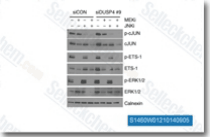
|
|
| S1133 | Alisertib (MLN8237) | Alisertib (MLN8237) is a selective Aurora A inhibitor with IC50 of 1.2 nM in a cell-free assay. It has >200-fold higher selectivity for Aurora A than Aurora B. Alisertib induces cell cycle arrest, apoptosis and autophagy. Phase 3. |
-S113303W0120130926.gif)
|
|
| S1147 | Barasertib-HQPA (AZD2811) | Defosbarasertib (AZD1152-HQPA, AZD2811, INH-34, Barasertib-HQPA) is a highly selective Aurora B inhibitor with IC50 of 0.37 nM in a cell-free assay, ~3700 fold more selective for Aurora B over Aurora A. Phase 1. |
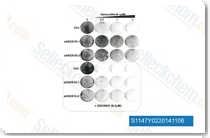
|
|
| S1048 | Tozasertib (VX-680) | Tozasertib (VX-680) is a pan-Aurora inhibitor, mostly against Aurora A with Kiapp of 0.6 nM in a cell-free assay, less potent towards Aurora B/Aurora C and 100-fold more selective for Aurora A than 55 other kinases. The only exceptions are Fms-related tyrosine kinase-3 (FLT-3) and BCR-ABL tyrosine kinase, which are inhibited by the Tozasertib with both Ki of 30 nM. Tozasertib induces apoptosis and autophagy. Phase 2. |
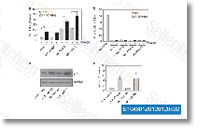
|
|
| S1103 | ZM 447439 | ZM 447439 is a selective and ATP-competitive inhibitor for Aurora A and Aurora B with IC50 of 110 nM and 130 nM, respectively. It is more than 8-fold selective for Aurora A/B than MEK1, Src, Lck and has little effect against CDK1/2/4, Plk1, Chk1, etc. |
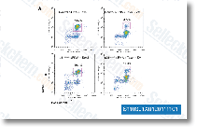
|
|
| S1100 | MLN8054 | MLN8054 is a potent and selective inhibitor of Aurora A with IC50 of 4 nM in Sf9 insect cell. It is more than 40-fold selective for Aurora A than Aurora B. Phase 1. |
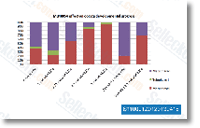
|
|
| S1107 | Danusertib (PHA-739358) | Danusertib (PHA-739358) is an Aurora kinase inhibitor for Aurora A/B/C with IC50 of 13 nM/79 nM/61 nM in cell-free assays, modestly potent to Abl, TrkA, c-RET and FGFR1, and less potent to Lck, VEGFR2/3, c-Kit, CDK2, etc. Danusertib induces apoptosis, cell cycle arrest, and autophagy. Phase 2. |
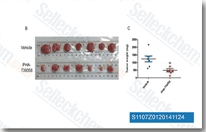
|
|
| S1529 | Hesperadin | Hesperadin potently inhibits Aurora B with IC50 of 250 nM in a cell-free assay. It markedly reduces the activity of AMPK, Lck, MKK1, MAPKAP-K1, CHK1 and PHK while it does not inhibit MKK1 activity in vivo. |
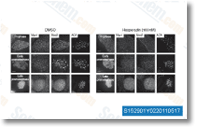
|
|
| S2770 | MK-5108 | MK-5108 is a highly selective Aurora A inhibitor with IC50 of 0.064 nM in a cell-free assay and is 220- and 190-fold more selective for Aurora A than Aurora B/C, while it inhibits TrkA with less than 100-fold selectivity. MK-5108 (VX-689) induces autophagy. Phase 1. |
-S277001W0220130927.gif)
|
|
| S1451 | TCS7010 (Aurora A Inhibitor I) | TCS7010 (Aurora A Inhibitor I) is a novel, potent, and selective inhibitor of Aurora A with IC50 of 3.4 nM in a cell-free assay. It is 1000-fold more selective for Aurora A than Aurora B. Aurora A Inhibitor I (TC-S 7010) triggers apoptosis through the ROS-mediated UPR signaling pathway. |
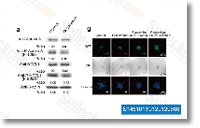
|
|
| S1134 | AT9283 | AT9283 is a potent JAK2/3 inhibitor with IC50 of 1.2 nM/1.1 nM in cell-free assays; also potent to Aurora A/B, Abl1(T315I). |
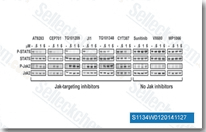
|
|
| S1249 | JNJ-7706621 | JNJ-7706621 is a pan-CDK inhibitor with the highest potency on CDK1/2 with IC50 of 9 nM/4 nM and showing >6-fold selectivity for CDK1/2 than CDK3/4/6 in cell-free assays. It also potently inhibits Aurora A/B and has no activity on Plk1 and Wee1. |
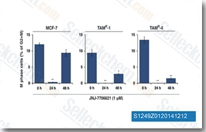
|
|
| S2719 | AMG-900 | AMG 900 is a potent and highly selective pan-Aurora kinases inhibitor for Aurora A/B/C with IC50 of 5 nM/4 nM /1 nM. It is >10-fold selective for Aurora kinases than p38α, Tyk2, JNK2, Met and Tie2. Phase 1. |
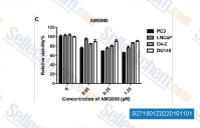
|
|
| S1454 | PHA-680632 | PHA-680632 is a potent inhibitor of Aurora A, Aurora B and Aurora C with IC50 of 27 nM, 135 nM and 120 nM, respectively. It has 10- to 200-fold higher IC50 for FGFR1, FLT3, LCK, PLK1, STLK2, and VEGFR2/3. |
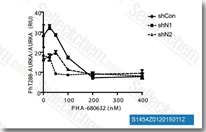
|
|
| S2158 | KW-2449 | KW-2449 is a multiple-targeted inhibitor, mostly for Flt3 with IC50 of 6.6 nM, modestly potent to FGFR1, Bcr-Abl and Aurora A; little effect on PDGFRβ, IGF-1R, EGFR. Phase 1. |
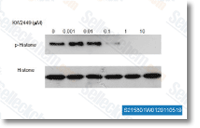
|
|
| S7588 | Reversine | Reversine is a potent human A3 adenosine receptor antagonist with Ki of 0.66 μM, and a pan-aurora A/B/C kinase inhibitor with IC50 of 400 nM/500 nM/400 nM, respectively. Also used for stem cell dedifferentiation. |
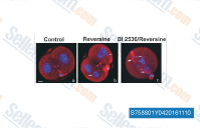
|
|
| S1154 | SNS-314 | SNS-314 Mesylate is a potent and selective inhibitor of Aurora A, Aurora B and Aurora C with IC50 of 9 nM, 31 nM, and 3 nM, respectively. It is less potent to Trk A/B, Flt4, Fms, Axl, c-Raf and DDR2. Phase 1. |
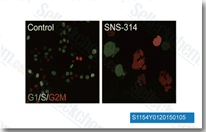
|
|
| S1181 | ENMD-2076 | ENMD-2076 has selective activity against Aurora A and Flt3 with IC50 of 14 nM and 1.86 nM, 25-fold selective for Aurora A than over Aurora B and less potent to RET, SRC, NTRK1/TRKA, CSF1R/FMS, VEGFR2/KDR, FGFR and PDGFRα. ENMD-2076 inhibits the growth of a wide range of human solid tumor and hematopoietic cancer cell lines with IC50 from 0.025 to 0.7 μM, which induces apoptosis and G2/M phase arrest. Phase 2. |
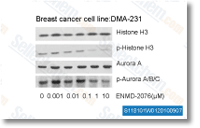
|
|
| S2740 | GSK1070916 | GSK1070916 is a reversible and ATP-competitive inhibitor of Aurora B/C with IC50 of 3.5 nM/6.5 nM. It displays >100-fold selectivity against the closely related Aurora A-TPX2 complex. Phase 1. |
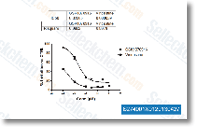
|
|
| S2744 | CCT137690 | CCT137690 is a highly selective inhibitor of Aurora A, Aurora B and Aurora C with IC50 of 15 nM, 25 nM and 19 nM. It has little effect on hERG ion-channel. |
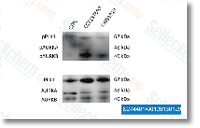
|
|
| S1171 | CYC116 | CYC116 is a potent inhibitor of Aurora A/B with Ki of 8.0 nM/9.2 nM, is less potent to VEGFR2 (Ki of 44 nM), with 50-fold greater potency than CDKs, not active against PKA, Akt/PKB, PKC, no effect on GSK-3α/β, CK2, Plk1 and SAPK2A. Phase 1. |
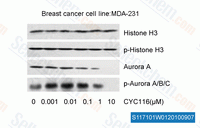
|
|
| S2718 | TAK-901 | TAK-901 is a novel inhibitor of Aurora A/B with IC50 of 21 nM/15 nM. It is not a potent inhibitor of cellular JAK2, c-Src or Abl. Phase 1. | ||
| S1051New | AZD1152(Barasertib) | AZD1152 is a selective inhibitor of Aurora B with Ki of 0.36 nM. | ||
| S7843 | BI-847325 | BI-847325 is an orally bioavailable, and selective dual MEK/Aurora kinase inhibitor with IC50 of 3 nM, 25 nM, 15 nM, 25 nM, and 4 nM for Xenopus laevis Aurora B, human Aurora A and Aurora C, as well as human MEK1 and MEK2, respectively. Phase 1. | ||
| S1519 | CCT129202 | CCT129202 is an ATP-competitive pan-Aurora inhibitor for Aurora A, Aurora B and Aurora C with IC50 of 0.042 μM, 0.198 μM and 0.227 μM, respectively. It is less potent to FGFR3, GSK3β, PDGFRβ, etc. |
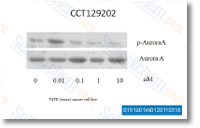
|
|
| S8699 | SNS-314 Mesylate | SNS-314 Mesylate is a potent and selective inhibitor of Aurora A, Aurora B and Aurora C with IC50 of 9 nM, 31 nM, and 3 nM, respectively and less potent to Trk A/B, Flt4, Fms, Axl, c-Raf and DDR2. | ||
| S8782 | LY3295668 | LY3295668 (AK-01) is a potent, orally active and specific inhibitor of Aurora A kinase with Ki of 0.8 nM and 1038 nM for AURKA and AURKB, respectively. | ||
| S9658 | SP-96 | SP-96 is a potent, selective and non-ATP-competitive inhibitor of Aurora B with IC50 of 0.316 nM. SP-96 can be used for the research of triple negative breast cancer (TNBC). | ||
| F0241 | Phospho-Aurora A/B/C (T288/232/198) Antibody [H12A24] | |||
| F1175 | Aurora A Antibody [P16M17] | Aurora A Mouse mAb recognizes endogenous levels of total Aurora A protein. | ||
| S7065 | MK-8745 | MK-8745 is a potent and selective Aurora A inhibitor with IC50 of 0.6 nM, more than 450-fold selectivity for Aurora A over Aurora B. | ||
| S2018 | ENMD-2076 L-(+)-Tartaric acid | ENMD-2076 L-(+)-Tartaric acid is the tartaric acid of ENMD-2076, selective activity against Aurora A and Flt3 with IC50 of 14 nM and 1.86 nM, 25-fold more selective for Aurora A than Aurora B and less potent to VEGFR2/KDR and VEGFR3, FGFR1 and FGFR2 and PDGFRα. Phase 2. |

|
|
| S9741 | TAS-119 | TAS-119 is a potent, selective, and orally active inhibitor of Aurora A, including Aurora B with an IC50 of 1.0 nM and 95 nM, respectively. It exhibits antitumor activities. | ||
| E0338 | AKI603 | AKI-603 is an inhibitor of Aurora kinase A (AurA), which is developed to overcome resistance mediated by BCR-ABL-T315I mutation. | ||
| E0342 | Aurora kinase Inhibitor II | Aurora kinase inhibitor II, an anilinoquinazoline that is both a potent and selective ATP-competitive inhibitor of Aurora kinase (ARK), has the ability to permeate the cell and is involved in the regulation of the cell cycle, particularly cell division. | ||
| E0616 | Chiauranib | Chiauranib (CS2164) selectively inhibits multiple kinase targets aurora B kinase (AURKB), colony-stimulating factor 1 receptor (CSF1R), and vascular endothelial growth factor receptor (VEGFR)/platelet-derived growth factor receptor (PDGFR)/c-Kit , thereby inhibiting the rapid proliferation of tumor cells, enhancing the antitumor immunity, and inhibiting tumor angiogenesis, to achieve the anti-tumor efficacy. | ||
| E5904New | 6K465 | 6K465 is a pyrimidine-based inhibitor of Aurora A, that reduces levels of c-MYC and N-MYC oncoproteins. It demonstrates compelling antitumor efficacy. | ||
| S2931 | Aurora Kinase Inhibitor III | Aurora kinase inhibitor III is a potent inhibitor of Aurora A kinase with an IC50 of 42 nM and has high selectivity for Aurora A over BMX, BTK, IGF-1R, c-Src, TRKB, SYK, and EGFR (IC50s = 386, 3,550, 591, 1,980, 2,510, 887, and >10,000 nM, respectively). | ||
| S6214 | H-1152 dihydrochloride | H-1152 dihydrochloride (2HCl) is a membrane-permeable and selective inhibitor of Rho-associated protein kinase (ROCK). H-1152 inhibits ROCK2, PKA, PKC, PKG, AuroraA and CaMK2 with IC50 of 0.0120 μM, 3.03 μM, 5.68 μM, 0.360 μM, 0.745 μM and 0.180 μM, respectively. | ||
| E1651 | CD532 | CD532 is a potent Aurora A kinase inhibitor with an IC50 of 45 nM. It breaks the native conformation of Aurora-A, drives the degradation of N-Myc in N-Myc-driven cancers, and also exhibits anti-proliferative effects. | ||
| S1272 | XL228 | XL228 is a protein kinase inhibitor with IC50 of 5 nM, 1.4 nM, 3.1 nM, 1.6 nM, 6.1 nM and 2 nM for wild-type ABL kinase, ABL T315I, Aurora A, IGF-1R, SRC and LYN, respectively. | ||
| E1435 | Tinengotinib | Tinengotinib (TT-00420) is a novel multiple kinase inhibitor that strongly inhibits Aurora A/B with IC50 values of 1.2/3.3 nM respectively. It also exhibits potent inhibitory activity on FGFR1/2/3, VEGFR1, JAK1/2, and CSF1R and can be used to treat several prominent signaling pathways in triple-negative breast cancer(TNBC). | ||
| S1460 | SP600125 | SP600125 (Nsc75890) is a broad-spectrum JNK inhibitor for JNK1, JNK2 and JNK3 with IC50 of 40 nM, 40 nM and 90 nM in cell-free assays, respectively; 10-fold greater selectivity against MKK4, 25-fold greater selectivity against MKK3, MKK6, PKB, and PKCα, and 100-fold selectivity against ERK2, p38, Chk1, EGFR etc. SP600125 is also a broad‐spectrum inhibitor of serine/threonine kinases including Aurora kinase A,FLT3 and TRKA with of IC50 of 60 nM, 90 nM and 70 nM. SP600125 inhibits autophagy and activates apoptosis. |

|
|
| S1133 | Alisertib (MLN8237) | Alisertib (MLN8237) is a selective Aurora A inhibitor with IC50 of 1.2 nM in a cell-free assay. It has >200-fold higher selectivity for Aurora A than Aurora B. Alisertib induces cell cycle arrest, apoptosis and autophagy. Phase 3. |
-S113303W0120130926.gif)
|
|
| S1147 | Barasertib-HQPA (AZD2811) | Defosbarasertib (AZD1152-HQPA, AZD2811, INH-34, Barasertib-HQPA) is a highly selective Aurora B inhibitor with IC50 of 0.37 nM in a cell-free assay, ~3700 fold more selective for Aurora B over Aurora A. Phase 1. |

|
|
| S1048 | Tozasertib (VX-680) | Tozasertib (VX-680) is a pan-Aurora inhibitor, mostly against Aurora A with Kiapp of 0.6 nM in a cell-free assay, less potent towards Aurora B/Aurora C and 100-fold more selective for Aurora A than 55 other kinases. The only exceptions are Fms-related tyrosine kinase-3 (FLT-3) and BCR-ABL tyrosine kinase, which are inhibited by the Tozasertib with both Ki of 30 nM. Tozasertib induces apoptosis and autophagy. Phase 2. |

|
|
| S1103 | ZM 447439 | ZM 447439 is a selective and ATP-competitive inhibitor for Aurora A and Aurora B with IC50 of 110 nM and 130 nM, respectively. It is more than 8-fold selective for Aurora A/B than MEK1, Src, Lck and has little effect against CDK1/2/4, Plk1, Chk1, etc. |

|
|
| S1100 | MLN8054 | MLN8054 is a potent and selective inhibitor of Aurora A with IC50 of 4 nM in Sf9 insect cell. It is more than 40-fold selective for Aurora A than Aurora B. Phase 1. |

|
|
| S1107 | Danusertib (PHA-739358) | Danusertib (PHA-739358) is an Aurora kinase inhibitor for Aurora A/B/C with IC50 of 13 nM/79 nM/61 nM in cell-free assays, modestly potent to Abl, TrkA, c-RET and FGFR1, and less potent to Lck, VEGFR2/3, c-Kit, CDK2, etc. Danusertib induces apoptosis, cell cycle arrest, and autophagy. Phase 2. |

|
|
| S1529 | Hesperadin | Hesperadin potently inhibits Aurora B with IC50 of 250 nM in a cell-free assay. It markedly reduces the activity of AMPK, Lck, MKK1, MAPKAP-K1, CHK1 and PHK while it does not inhibit MKK1 activity in vivo. |

|
|
| S2770 | MK-5108 | MK-5108 is a highly selective Aurora A inhibitor with IC50 of 0.064 nM in a cell-free assay and is 220- and 190-fold more selective for Aurora A than Aurora B/C, while it inhibits TrkA with less than 100-fold selectivity. MK-5108 (VX-689) induces autophagy. Phase 1. |
-S277001W0220130927.gif)
|
|
| S1451 | TCS7010 (Aurora A Inhibitor I) | TCS7010 (Aurora A Inhibitor I) is a novel, potent, and selective inhibitor of Aurora A with IC50 of 3.4 nM in a cell-free assay. It is 1000-fold more selective for Aurora A than Aurora B. Aurora A Inhibitor I (TC-S 7010) triggers apoptosis through the ROS-mediated UPR signaling pathway. |

|
|
| S1134 | AT9283 | AT9283 is a potent JAK2/3 inhibitor with IC50 of 1.2 nM/1.1 nM in cell-free assays; also potent to Aurora A/B, Abl1(T315I). |

|
|
| S1249 | JNJ-7706621 | JNJ-7706621 is a pan-CDK inhibitor with the highest potency on CDK1/2 with IC50 of 9 nM/4 nM and showing >6-fold selectivity for CDK1/2 than CDK3/4/6 in cell-free assays. It also potently inhibits Aurora A/B and has no activity on Plk1 and Wee1. |

|
|
| S2719 | AMG-900 | AMG 900 is a potent and highly selective pan-Aurora kinases inhibitor for Aurora A/B/C with IC50 of 5 nM/4 nM /1 nM. It is >10-fold selective for Aurora kinases than p38α, Tyk2, JNK2, Met and Tie2. Phase 1. |

|
|
| S1454 | PHA-680632 | PHA-680632 is a potent inhibitor of Aurora A, Aurora B and Aurora C with IC50 of 27 nM, 135 nM and 120 nM, respectively. It has 10- to 200-fold higher IC50 for FGFR1, FLT3, LCK, PLK1, STLK2, and VEGFR2/3. |

|
|
| S2158 | KW-2449 | KW-2449 is a multiple-targeted inhibitor, mostly for Flt3 with IC50 of 6.6 nM, modestly potent to FGFR1, Bcr-Abl and Aurora A; little effect on PDGFRβ, IGF-1R, EGFR. Phase 1. |

|
|
| S7588 | Reversine | Reversine is a potent human A3 adenosine receptor antagonist with Ki of 0.66 μM, and a pan-aurora A/B/C kinase inhibitor with IC50 of 400 nM/500 nM/400 nM, respectively. Also used for stem cell dedifferentiation. |

|
|
| S1154 | SNS-314 | SNS-314 Mesylate is a potent and selective inhibitor of Aurora A, Aurora B and Aurora C with IC50 of 9 nM, 31 nM, and 3 nM, respectively. It is less potent to Trk A/B, Flt4, Fms, Axl, c-Raf and DDR2. Phase 1. |

|
|
| S1181 | ENMD-2076 | ENMD-2076 has selective activity against Aurora A and Flt3 with IC50 of 14 nM and 1.86 nM, 25-fold selective for Aurora A than over Aurora B and less potent to RET, SRC, NTRK1/TRKA, CSF1R/FMS, VEGFR2/KDR, FGFR and PDGFRα. ENMD-2076 inhibits the growth of a wide range of human solid tumor and hematopoietic cancer cell lines with IC50 from 0.025 to 0.7 μM, which induces apoptosis and G2/M phase arrest. Phase 2. |

|
|
| S2740 | GSK1070916 | GSK1070916 is a reversible and ATP-competitive inhibitor of Aurora B/C with IC50 of 3.5 nM/6.5 nM. It displays >100-fold selectivity against the closely related Aurora A-TPX2 complex. Phase 1. |

|
|
| S2744 | CCT137690 | CCT137690 is a highly selective inhibitor of Aurora A, Aurora B and Aurora C with IC50 of 15 nM, 25 nM and 19 nM. It has little effect on hERG ion-channel. |

|
|
| S1171 | CYC116 | CYC116 is a potent inhibitor of Aurora A/B with Ki of 8.0 nM/9.2 nM, is less potent to VEGFR2 (Ki of 44 nM), with 50-fold greater potency than CDKs, not active against PKA, Akt/PKB, PKC, no effect on GSK-3α/β, CK2, Plk1 and SAPK2A. Phase 1. |

|
|
| S2718 | TAK-901 | TAK-901 is a novel inhibitor of Aurora A/B with IC50 of 21 nM/15 nM. It is not a potent inhibitor of cellular JAK2, c-Src or Abl. Phase 1. | ||
| S1051New | AZD1152(Barasertib) | AZD1152 is a selective inhibitor of Aurora B with Ki of 0.36 nM. | ||
| S7843 | BI-847325 | BI-847325 is an orally bioavailable, and selective dual MEK/Aurora kinase inhibitor with IC50 of 3 nM, 25 nM, 15 nM, 25 nM, and 4 nM for Xenopus laevis Aurora B, human Aurora A and Aurora C, as well as human MEK1 and MEK2, respectively. Phase 1. | ||
| S1519 | CCT129202 | CCT129202 is an ATP-competitive pan-Aurora inhibitor for Aurora A, Aurora B and Aurora C with IC50 of 0.042 μM, 0.198 μM and 0.227 μM, respectively. It is less potent to FGFR3, GSK3β, PDGFRβ, etc. |

|
|
| S8699 | SNS-314 Mesylate | SNS-314 Mesylate is a potent and selective inhibitor of Aurora A, Aurora B and Aurora C with IC50 of 9 nM, 31 nM, and 3 nM, respectively and less potent to Trk A/B, Flt4, Fms, Axl, c-Raf and DDR2. | ||
| S8782 | LY3295668 | LY3295668 (AK-01) is a potent, orally active and specific inhibitor of Aurora A kinase with Ki of 0.8 nM and 1038 nM for AURKA and AURKB, respectively. | ||
| S9658 | SP-96 | SP-96 is a potent, selective and non-ATP-competitive inhibitor of Aurora B with IC50 of 0.316 nM. SP-96 can be used for the research of triple negative breast cancer (TNBC). | ||
| S7065 | MK-8745 | MK-8745 is a potent and selective Aurora A inhibitor with IC50 of 0.6 nM, more than 450-fold selectivity for Aurora A over Aurora B. | ||
| S2018 | ENMD-2076 L-(+)-Tartaric acid | ENMD-2076 L-(+)-Tartaric acid is the tartaric acid of ENMD-2076, selective activity against Aurora A and Flt3 with IC50 of 14 nM and 1.86 nM, 25-fold more selective for Aurora A than Aurora B and less potent to VEGFR2/KDR and VEGFR3, FGFR1 and FGFR2 and PDGFRα. Phase 2. |

|
|
| S9741 | TAS-119 | TAS-119 is a potent, selective, and orally active inhibitor of Aurora A, including Aurora B with an IC50 of 1.0 nM and 95 nM, respectively. It exhibits antitumor activities. | ||
| E0338 | AKI603 | AKI-603 is an inhibitor of Aurora kinase A (AurA), which is developed to overcome resistance mediated by BCR-ABL-T315I mutation. | ||
| E0342 | Aurora kinase Inhibitor II | Aurora kinase inhibitor II, an anilinoquinazoline that is both a potent and selective ATP-competitive inhibitor of Aurora kinase (ARK), has the ability to permeate the cell and is involved in the regulation of the cell cycle, particularly cell division. | ||
| E0616 | Chiauranib | Chiauranib (CS2164) selectively inhibits multiple kinase targets aurora B kinase (AURKB), colony-stimulating factor 1 receptor (CSF1R), and vascular endothelial growth factor receptor (VEGFR)/platelet-derived growth factor receptor (PDGFR)/c-Kit , thereby inhibiting the rapid proliferation of tumor cells, enhancing the antitumor immunity, and inhibiting tumor angiogenesis, to achieve the anti-tumor efficacy. | ||
| E5904New | 6K465 | 6K465 is a pyrimidine-based inhibitor of Aurora A, that reduces levels of c-MYC and N-MYC oncoproteins. It demonstrates compelling antitumor efficacy. | ||
| S2931 | Aurora Kinase Inhibitor III | Aurora kinase inhibitor III is a potent inhibitor of Aurora A kinase with an IC50 of 42 nM and has high selectivity for Aurora A over BMX, BTK, IGF-1R, c-Src, TRKB, SYK, and EGFR (IC50s = 386, 3,550, 591, 1,980, 2,510, 887, and >10,000 nM, respectively). | ||
| S6214 | H-1152 dihydrochloride | H-1152 dihydrochloride (2HCl) is a membrane-permeable and selective inhibitor of Rho-associated protein kinase (ROCK). H-1152 inhibits ROCK2, PKA, PKC, PKG, AuroraA and CaMK2 with IC50 of 0.0120 μM, 3.03 μM, 5.68 μM, 0.360 μM, 0.745 μM and 0.180 μM, respectively. | ||
| E1651 | CD532 | CD532 is a potent Aurora A kinase inhibitor with an IC50 of 45 nM. It breaks the native conformation of Aurora-A, drives the degradation of N-Myc in N-Myc-driven cancers, and also exhibits anti-proliferative effects. | ||
| S1272 | XL228 | XL228 is a protein kinase inhibitor with IC50 of 5 nM, 1.4 nM, 3.1 nM, 1.6 nM, 6.1 nM and 2 nM for wild-type ABL kinase, ABL T315I, Aurora A, IGF-1R, SRC and LYN, respectively. | ||
| E1435 | Tinengotinib | Tinengotinib (TT-00420) is a novel multiple kinase inhibitor that strongly inhibits Aurora A/B with IC50 values of 1.2/3.3 nM respectively. It also exhibits potent inhibitory activity on FGFR1/2/3, VEGFR1, JAK1/2, and CSF1R and can be used to treat several prominent signaling pathways in triple-negative breast cancer(TNBC). | ||
| S1051New | AZD1152(Barasertib) | AZD1152 is a selective inhibitor of Aurora B with Ki of 0.36 nM. | ||
| E5904New | 6K465 | 6K465 is a pyrimidine-based inhibitor of Aurora A, that reduces levels of c-MYC and N-MYC oncoproteins. It demonstrates compelling antitumor efficacy. |
